Once you know how to cook dried lentils, you'll always have them on hand. They're cheap, nutritious and easy to make. They need no soaking in most cases, and - most importantly - they're delicious!
Lentils are extremely versatile and there are thousands of lentil recipes in the world. One of the best things about lentils, though, is that you don’t need a set recipe to whip up an amazing meal. Once you learn how to cook lentils, there is no stopping you from creating quick and healthy meals for your family!
Not only are lentils tasty and easy to cook, but these tiny legumes are also packed full of protein, fibre, folate, and health-promoting phytochemicals. They have a delicious ability to add depth to your salads, side dishes, and more. Additionally, they're extremely affordable, you can create a meal for a family of 6 for less than $1 per serving.
What's not to love about these mighty legumes?! It's no wonder they're so abundant in most cultures around the world.
How to Cook Lentils
Let's learn my four favourite methods of cooking lentils, I'll even add some information about the different varieties. You will never be stumped at dinner time again. My methods for preparing your lentils are really easy! You only need to follow three steps.
A quick sort. Discard any lentils that are cracked, broken, and any stones or debris.
A good rinse. Give the lentils a good rinse under cold water. There are two ways to rinse your lentils:
- The first way is to fill a bowl with lentils and water and rub the lentils with your hands and then drain. Repeat this a few times.
- The second way is to place the lentils in a colander and rinse well under cold water. Again, rub the lentils with your hands to remove any dust or impurities that can occur with natural products.
Let's get simmering! Fill a pot with your lentils and plenty of water: it should reach 2 inches above the lentils. I usually add 4 cups of water to every cup of lentils, this is just a general suggestion, not a hard rule.
Cook lentils to recommended timing and add salt once finished cooking.
Important tips on how to cook dried lentils
- Don’t cook lentils in aluminum or cast iron pans. These metals inhibit cooking and affect the colour and/or taste of the lentils.
- Lentils should be cooked al dente; tender, but not mushy. Except for red lentils.
- Acidic ingredients should be added only after lentils are cooked to the desired tenderness. A squeeze of fresh lemon juice near the end of cooking brightens their earthy flavour in most cases.
- Lentils do not need pre-soaking.
- Lentil flavours benefit from adding aromatics, like onions, garlic, cinnamon, and bay leaves in the cooking water.
- Salt at the end of cooking, not during the cooking process.
- Using a Brine Method softens the skin of the lentils to help prevent lentils from falling apart during longer cooking periods; like braising.
Types of dried Lentils and cooking times
There are four categories of lentils: brown, red, green, & specialty. Let's take a deep dive into the most commonly found lentil types, recipes used, and cooking methods.
The Green Lentil

The green lentils: are less likely to break down during cooking, they're the largest of the lentils. They have a mild earthy flavour and creamy texture. When cooking dried lentils, if you find that your lentil does break during cooking, you can use a brine method. This will help soften the skin before cooking, so they are less likely to burst. Be aware that using the brine method reduces the cooking time in most cases.
They're most commonly used in salads, soups, side dishes, and rice dishes.
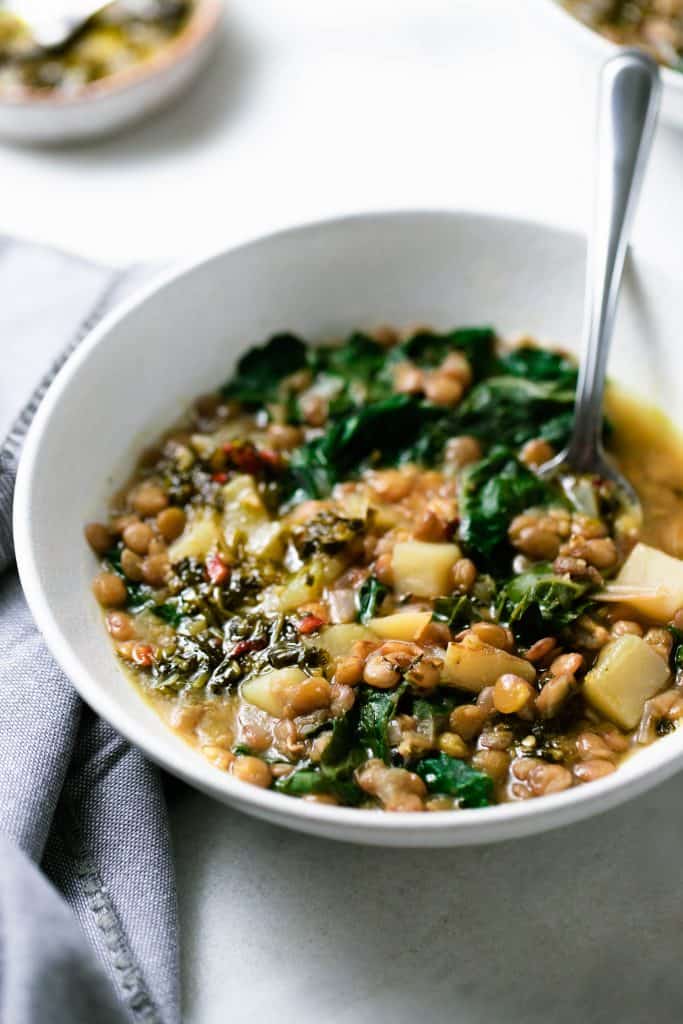
Green Lentil Cooking Methods & Time
Brine method: soak 1 cup of lentils in 4 cups of water with 1 tablespoon of sea salt for 1 hour. After the lentils have been soaked, drain and rinse the lentils. Use this method for any recipe that calls for longer cooking times or when baking in the oven.
Stovetop cooking method: 1 cup of dried lentils and 4 cups of water. Simmer. Once the lentils are al dente, add salt to the water allow the lentils to sit in the salty water for 5 minutes. The salt helps bring out the earthy flavours of the lentils, but it shouldn't be added until lentils have softened.
Stovetop cooking time: 15 to 20 minutes.
Instant pot method: 1 cup of lentil and 4 cups of water. Set a low-pressure cook setting. Time 7 minutes. Quick-release and drain
Yield: 1 cup dried lentils = 2 ½ cups cooked.
Recipes to Try with Green Lentils
The Brown Lentil
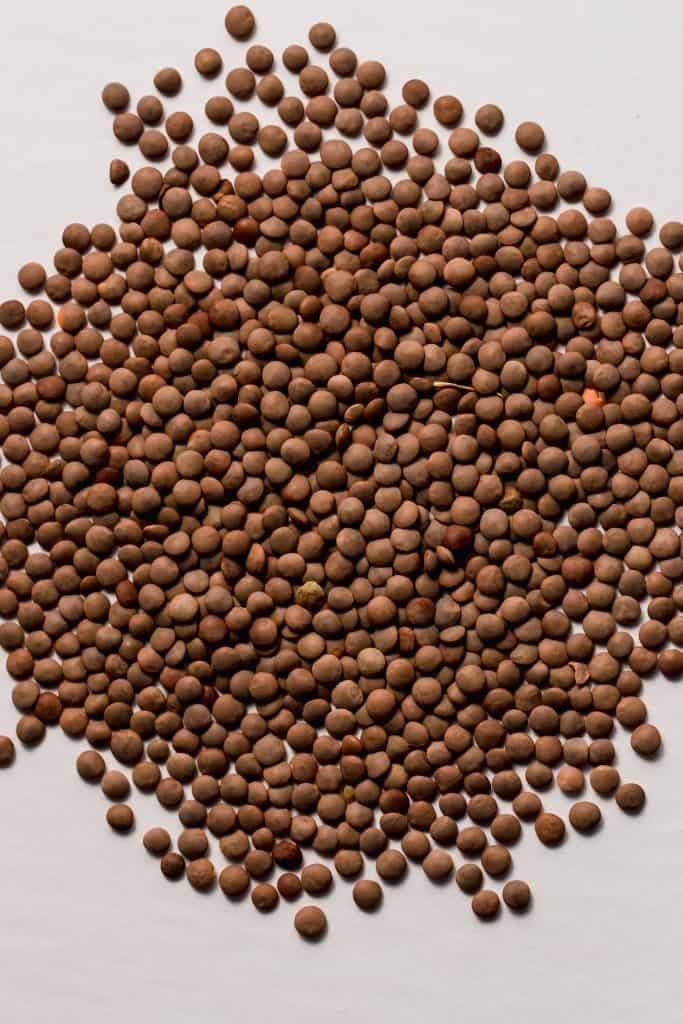
Brown lentils: these are the most common and versatile lentils. They have a mild earthy flavour and a creamy texture. I find they tend to lose a little bit of shape once cooked and they can be easily overcooked. But they are really tasty when cooked right. The brining method works really well with these lentils.
These lentils are commonly used in warm salads, casseroles, soups, stews, veggie burgers, vegetarian meatloaf and even in pasta dishes. Like I said they're versatile!

Brown Lentil Cooking Methods & Time
Brine method: soak 1 cup of lentils in 4 cups of water with 1 tablespoon of sea salt for 1 hour. After the lentils have been soaked, drain and rinse the lentils. Use this method for any recipe that calls for longer cooking times or when baking in the oven.
Stovetop cooking method: 1 cup of dried lentils and 4 cups of water. Simmer. Once the lentils are al dente, add salt to the water and allow the lentils to sit in the salty water for 5 minutes. The salt helps bring out the earthy flavours of the lentils but shouldn't be added until lentils have softened.
Cooking time: 10 to 15 minutes.
Instant pot method: 1 cup of lentil and 4 cups of water. Set low-pressure cook setting. Time 7 minutes. Quick-release and drain
1 cup dried lentils = 2 ½ cups cooked
Recipes to Try With Brown Lentils
Makhlouta-Lebanese Whole Grain Stew
The Red Lentil

Red lentils: they're simple brown lentils skinned and spilt. They can come in a bright red-orange colour or pail orange-yellowish colour. Red lentils completely disintegrate once cooked.
Red lentils are most commonly used for soups, curries, veggie burgers and recipe thickeners.
Red Lentil Cooking Methods & Time
Cooking on the stovetop: 1 cup of dried lentils and 2 ⅓ cups of water. Simmer. Salt these lentils whenever you feel like it, salt won't affect these lentils at all.
Cooking time: 5 to 10 minutes. 10-20 minutes for puree.
Instant pot method: the instant pot timing and setting for red lentils depends on the recipe you are using. Red lentils aren't normally prepared and stored for later.
1 cup dried lentils = 2 cups cooked
Le Puy or French Green Lentil
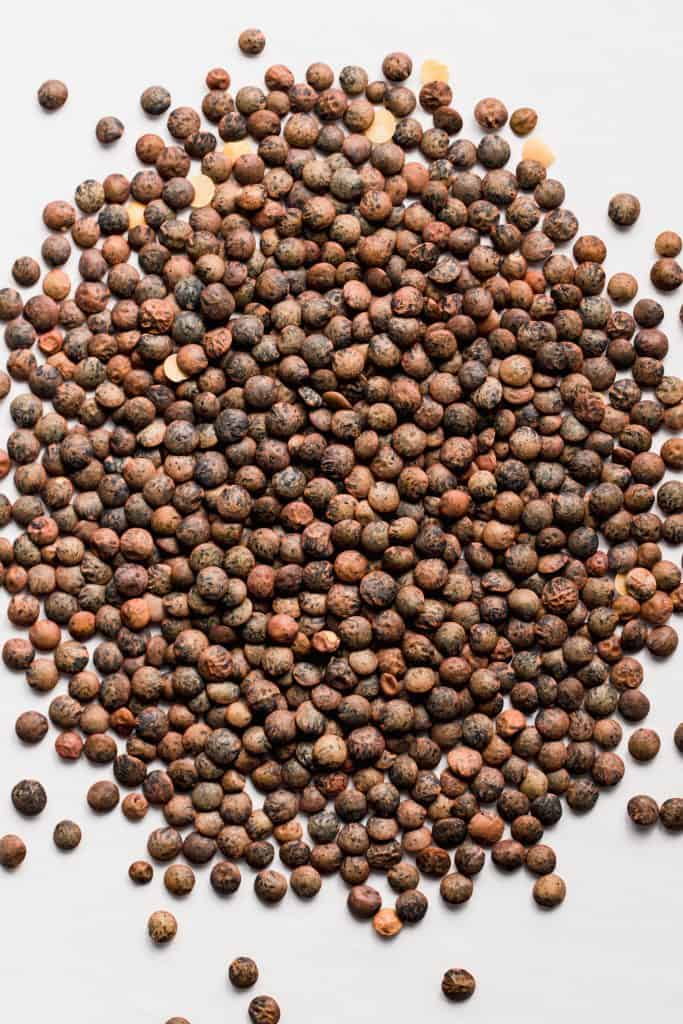
Le Puy or French Lentils: these have a complex flavour; rich, earthy with a firm yet tender texture. These lentils are grown in volcanic soil in the Le Puy region of France. That's probably why they're so expensive to buy. They are definitely worth the extra cost. They keep their shape really well and make great lentils for any dish where the lentils will take centre stage. When braising these lentils, the brine method is recommended.
These are usually used in salads and in any recipe calling for lentils to be the main feature of the dish.

French Lentil Cooking Methods & Time
Brine method: soak 1 cup of lentils in 4 cups of water with 1 tablespoon of sea salt for 1 hour. After the lentils have been soaked, drain and rinse the lentils. Use this method for any recipe that calls for longer cooking times or when baking in the oven.
Stovetop cooking method: 1 cup of dried lentils in 4 cups of water. Simmer. Once the lentils are al dente, add salt to the water, allow the lentils to sit in the salty water for 5 minutes. The salt helps bring out the earthy flavours of the lentils, but it shouldn't be added until the lentils have softened.
Stovetop cooking time: 15 to 20 minutes.
Instant pot method: 1 cup of lentil and 4 cups of water. Set a low-pressure cook setting. Time 0 minutes (yes, 0 minutes! you just need the pressure to be achieved.). Slow-release and drain.
1 cup dried lentils = 2 ½ cups cooked
Recipes to Try with French Lentils
Roasted Cauliflower Salad with Sweet Tahini Dressing
The Beluga Lentil
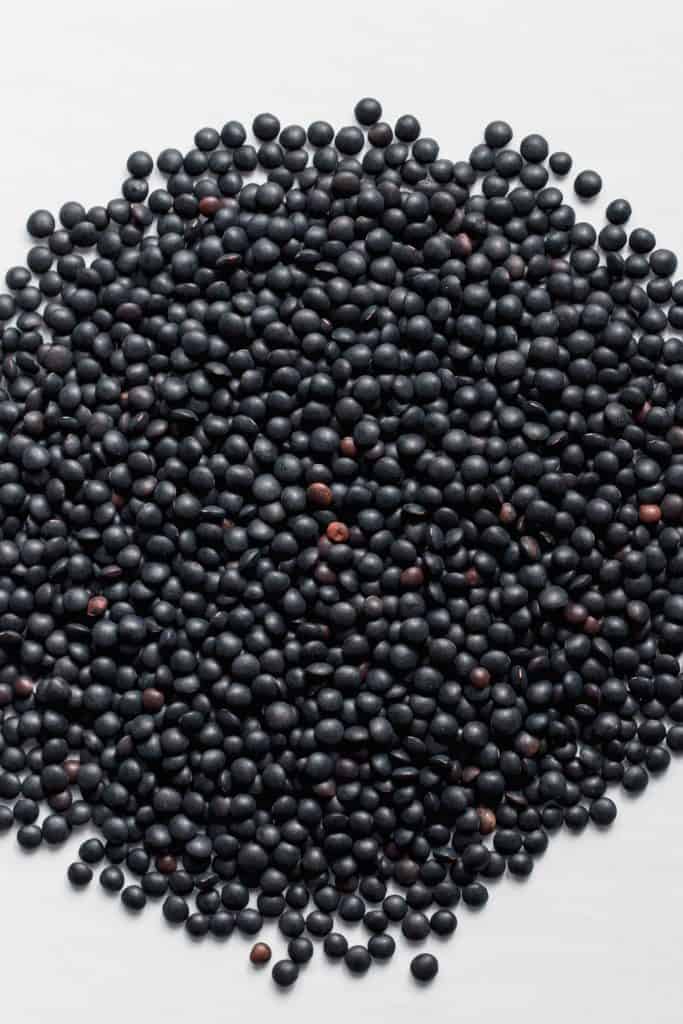
Beluga Lentils: the smallest of lentils. They have a deep black colour that mellows out once cooked, resulting in a dark muddy looking dish. They have a robust flavour and hold their shape really well. Best for braised dishes
1 cup dried lentils = 2 ½ cups cooked

Beluga Lentil Cooking Methods & Time
Brine method: soak 1 cup of lentils in 4 cups of water with 1 tablespoon of sea salt for 1 hour. After the lentils have been soaked, drain and rinse the lentils. Use this method for any recipe that calls for longer cooking times or when baking in the oven.
Stovetop Cooking Method. 1 cup of dried lentils and 4 cups of water. Simmer. Once the lentils are al dente, add salt to the water allow the lentils to sit in the salty water for 5 minutes. The salt helps bring out the earthy flavours of the lentils but shouldn't be added until lentils have softened.
Stovetop Cooking time: 10 to 15 minutes.
Instant pot method: 1 cup of lentils and 4 cups of water. Set a low-pressure cook setting. Time 0 minutes (yes, 0 minutes! you just need the pressure to be achieved.). Slow-release and drain.


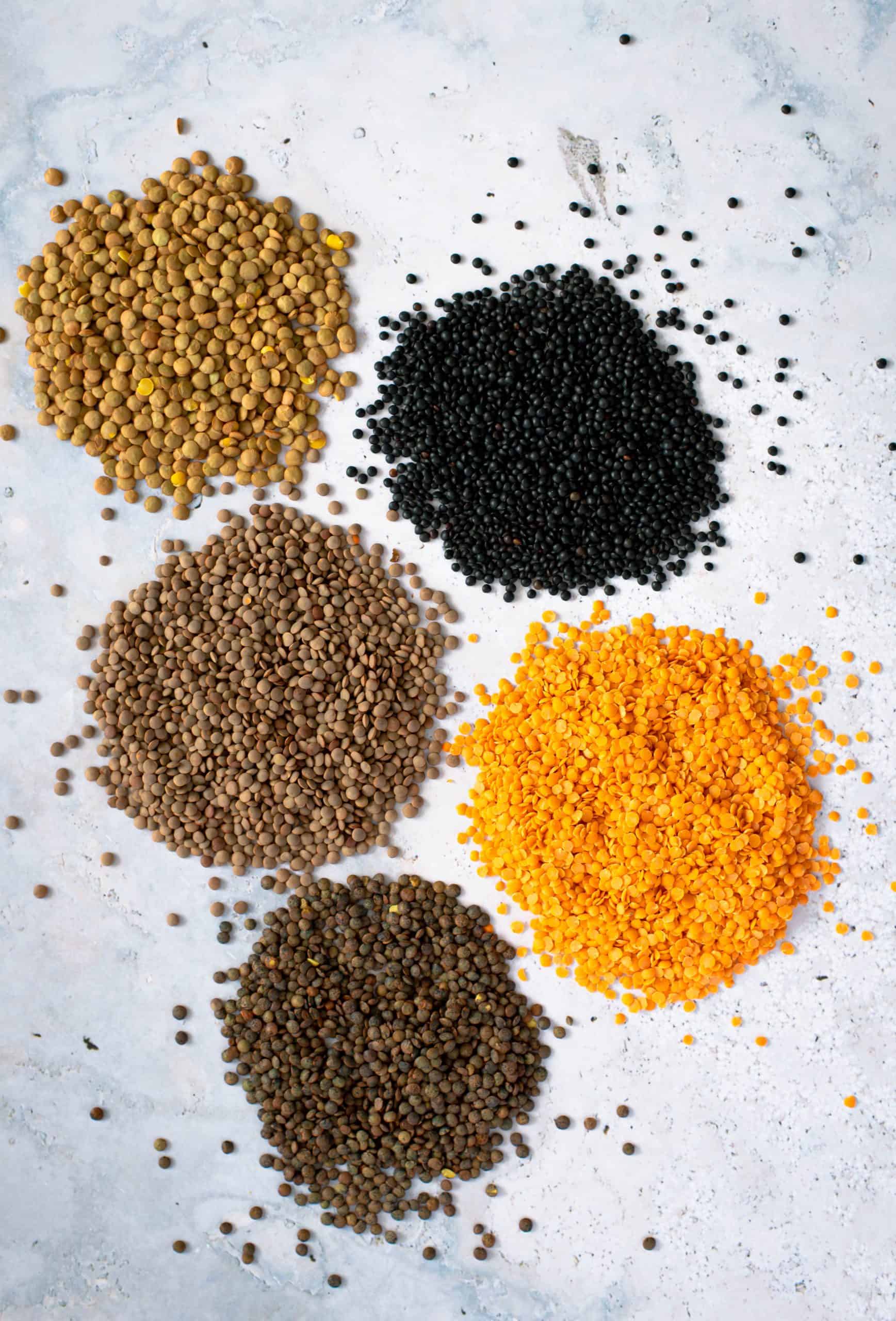




Simon
That's odd and new to me but worth a try suppose.
1. They need no soaking in most cases.
Don't they have like a protective layer if something that binds to the nutrients and (partially) inhibits their digestion/absorption?
2. Adding salt at the end.
I feel like I read this before but I don't think I ever tried, so maybe I should I guess.
My approach is always the same: soak overnight or longer, take the water away and rinse a few times, place in a pot and add water, salt and bay leaves and cook for like 20 minutes.
Sarah
Lentil can be cooked without soaking. However, if you soak the lentils, you'll need to reduce the cooking time.
Thank you for your comment. Soaking the lentils is believed to remove lectins from the outer skins of the lentils. This theory is based on the macrobiotic diet beliefs of how to cook grains. The "soak or not to soak lentils" is a bit controversial, with both opinions having their merits. For myself, I find it to be an extra step that's not necessary in most cases unless you're using a brining method, so the lentils do not fall apart during the cooking process.
I hope this helps.